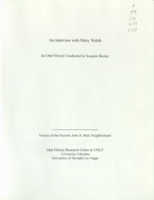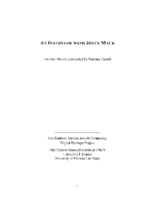Search the Special Collections and Archives Portal
Search Results
Urban Chamber of Commerce of Las Vegas, Nevada Records
Identifier
Abstract
The Urban Chamber of Commerce of Las Vegas, Nevada Records date from approximately 1980 to 2009 and contains the organizational records of the Urban Chamber of Commerce of Las Vegas, Nevada (UCC), one of the many chambers of commerce in the Las Vegas, Nevada area. The mission of the Urban Chamber of Commerce is to create and foster an environment that promotes development of members and Black-owned businesses. The collection is comprised of publications, financial and administrative records, various event information, and photographs of events and membership.
Archival Collection
Kay Royer Red Cross Scrapbook
Identifier
Abstract
The Kay Royer Red Cross Scrapbook contains black-and-white photographic prints, newspaper clippings, and personal correspondence collected by Sarah "Kay" Royer while stationed at the 248th General Hospital and 4th General Hospital in the Philippines from 1945 to 1948. The scrapbook contains newspaper clippings with commentary written by Royer documenting her training at the American University in Washington, D.C., the journey to Manila, and her time spent there working in various hospitals. Included in the scrapbook are letters from soldiers thanking the nurses for their care, dance cards, menus from holidays and special occasions, and hand-drawn sketches given to Royer.
Archival Collection
Betty Henderson Professional Papers
Identifier
Abstract
The Betty Henderson Professional Papers (1963-1985) are comprised of materials produced by Betty Henderson in her capacity as a private music teacher in Las Vegas, Nevada and as a member of the Nevada Music Teachers Association (NMTA). The collection includes scrapbooks of concert programs and NMTA events, materials from Henderson's experiences in Europe as a People-to-People ambassador with the Music Teachers National Association, and recordings on reel-to-reel tapes of concerts Henderson performed in or judged.
Archival Collection
Aaron Williams Papers
Identifier
Abstract
Aaron Williams Papers (1965-1981) consist of scrapbooks, newspaper clippings, scrapbooks, certificates, newspaper clippings, reports, and programs. Many of the clippings and some of the correspondence contain references that give insight into the role of women in North Las Vegas and Clark County, Nevada during the late 1960s and early 1970s. The scrapbooks and newspaper clippings document Williams' career as well as issues he dealt with as councilman and commissioner. These issues include those related to community and infrastructure development, such as airports, sewage treatment plants, senior citizens, health, and urban planning as well as North Las Vegas and Clark county political activities during the late 1960s and early 1970s.
Archival Collection
Nevada Hotel and Motel Association Collection
Identifier
Abstract
The Nevada Hotel and Motel Association Collection contains items from the hospitality and service industries from 1979 to 1992. The collection consists of trade publications, conference brochures, and industry reports focusing on the service and hospitality industries in Nevada.
Archival Collection
Ham, Artemus W., Sr., 1892-1970
Artemus W. “Art” Ham Sr. (1892-1970) was a highly respected Las Vegas, Nevada attorney and a philanthropist who devoted his work towards the Las Vegas community as well as the development of the Las Vegas strip. Ham was also president of the Las Vegas Chamber of Commerce in 1929 and a recognized supporter to the University of Las Vegas, Nevada (UNLV). He became active in the city’s real estate and had faith in the future of Las Vegas.
Person

Transcript of interview with Marty Walsh by Suzanne Becker, July 19, 2007
Date
Archival Collection
Description
In 2002, Marty Walsh and her husband purchased a home in the John S. Park Neighborhood. Three aspects attracted them to their 1941-built home: the quality construction; the aesthetics and details of the house; and the "old-fashion human element" that she associated with her grandparents. Marty describes their relocation to Las Vegas after living for nine years in Ireland and her joy of discovering the John S. Park community. For her there is a neighborliness that they found in the form of the Neighborhood Watch. She feels the neighborhood still has work to do, but the gentrification has had splendid results as new "urbanites" replace original homeowners. From her artist point of view, she also provides thoughts about the impact the artist community of musicians, painters, and creative artists has had on the neighborhood. Even though she is relatively new to Las Vegas, she is well researched in the historic aspects of John S. Park location: once a fertile plot of land where
Text

Transcript of interview with Joyce Mack by Barbara Tabach, February 23, 2015
Date
Archival Collection
Description
In this interview, Joyce Mack discusses meeting her husband, Jerry Mack, in Los Angeles,their early life as a couple, and moving to Las Vegas at the suggestion of Jerry's father, Nate Mack. She discusses how Jerry met Parry Thomas and their banking and real estate investments. Mrs. Mack talks about the opening of the Thomas and Mack Center at UNLV, and the development of the strip hotels, and discusses her children.
Joyce Mack: wife to Jerry Mack and matriarch of one of the most influential families of Las Vegas history. During this oral history conversation, she begins by tracing her family ancestry from Kiev to New York to Omaha and then Los Angeles, where she was born and raised. At a UCLA fraternity party in the early 1940s, a teenage Joyce Rosenberg was swept off her feet by her older brother's friend Jerry Mack. Jerry was from Boulder City, Nevada and had attended school in Las Vegas. In 1946, the couple married and took an extended honeymoon throughout the United States and Cuba. Soon afterwards, Jerry's father Nate Mack, a businessman and real estate developer encouraged the newlyweds to come to Las Vegas. She tells of Jerry sharing his vision of the valley's future. Thus began a successful journey that traverses decades of Las Vegas history and breathtaking growth in which the Macks were active participants and leaders. Joyce recalls the people the first met, who they raised their children side-by-side with and became lasting friends. These people were other Las Vegas pioneers including the Greenspuns and mostly importantly her husband's partnership with Parry Thomas which created the Bank of Las Vegas. It was their partnership she explains that reduced the presence of the mob element. As members of the small Jewish community of the late 1940s, the Macks would participate in the founding of Temple Beth Sholom.
Text

Transcript of interview with Santo Savino by Lisa Gioia-Acres, September 23, 2008
Date
Archival Collection
Description
Santo was born in the Bronx, New York in 1937. Santo’s family includes his father who was a butcher, and his mother who mostly stayed at home to raise the children, as well as a brother who currently lives with Santo. Santo recalls that it was great growing up in the Bronx, and he spent most of his life there until he joined the Air Force when he was 17. Santo’s immediate family was not musically oriented, but he learned to play the drums from a cousin. Music came easy for Santo, and he started getting paid for playing when he was 12. At 17, Santo joined the Air Force with a group of friends. He auditioned for and was accepted into the Air Force band where he played drums for four years. Santo was married with a child and another child on the way when he ended his military career and moved to California. After jobs working as a security guard and on an assembly line, Santo knew he just wanted to play and came to Las Vegas in 1960 to play with a band. It took several years before Santo was able to get on with a permanent band. Once Santo broke into the scene in Las Vegas, he played for six years at the Flamingo. Following that he was on the road for a couple of years with Paul Anka. Upon returning to Las Vegas, Santo worked for 14 years at the Sahara. Santo talks about when “the boys” had the hotels before the corporations came in and how everything changed. Currently, Santo does a lot of work with trumpet player Carl Saunders, frequently traveling to Los Angeles to do recordings together.
Text

Transcript of interview with Dorothy Pitzer by Judy Harrell, May 19, 2014
Date
Archival Collection
Description
Born in Chicago and raised in small Illinois towns, Dorothy Karper met her future husband, Doug Pitzer, when they went to rival high schools. She began nurses’ training in Dixon, Illinois, and immediately after her 1950 graduation, Dorothy and Doug married. Although he never had to go overseas, the Korean War interrupted their married life, and Doug enlisted in the Air Force and went to basic training in Texas. The couple arrived in Las Vegas in July 1954, when Doug was transferred to Nellis Air Force Base. Dorothy worked as a nurse at Las Vegas Hospital and Clinic 1954-1957 and later worked for a private obstetrics practice. From 1954 until Doug’s discharge in 1957 the Pitzers lived in Kelso-Turner Terrace military housing. In 1956 they purchased a new house in Twin Lakes, but they didn't move in until 1957, after the streets were put in. They remained in their Twin Lakes house until they moved into Dorothy’s present house on Burton Avenue, between West Charleston Boulevard
Text
